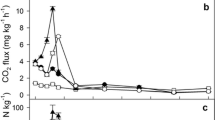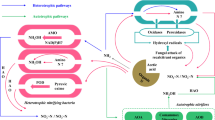Abstract
To quantify the contribution of denitrification and autotrophic and heterotrophic nitrification to N2O production in Andosols with a relatively high organic matter content, we first examined the effect of C2H2 concentrations on N2O production and on changes in mineral N contents. The optimum C2H2 concentration for inhibiting autotrophic nitrification was 10 Pa. Secondly, and Andosol taken from an arable field was incubated for 32 days at 30°C at 60, 80, and 100% water-holding capacity with or without the addition of NH +4 or NO sup-inf3 (200 mg N kg-1), and subsamples collected every 4–8 days were further incubated for 24 h with or without C2H2 (10 Pa). At 60 and 80% water-holding capacity with NH +4 added, 87–92% of N2O produced (200–250 μg N2O−N kg-1) was derived from autotrophic nitrification. In contrast, at 100% water-holding capacity with or without added NO sup-inf3 , enormous amounts of N2O (29–90 mg N2O−N kg-1) were produced rapidly, mostly by denitrification (96–98% of total production). Thirdly, to examine N2O production by heterotrophic nitrification, the Andosol was amended with peptone or NH +4 (both 1000 mg N kg-1)+citric acid (20 g C kg-1) and with or without dicyandiamide (200 mg N kg-1). Treatment with citric acid alone or with citric acid+dicyandiamide suppressed N2O production. In contrast, peptone increased N2O production (5.66 mg N2O−N kg-1) mainly by denitrification (80% of total production). However, dicyandiamide reduced N2O production to 1.1 mg N2O−N kg-1. These results indicate that autotrophic nitrification was the main process for N2O production except at 100% water-holding capacity where denitrification became dominant and that heterotrophic nitrification had a lesser importance in the soils examine.
Similar content being viewed by others
References
Anderson JM, Ingram JSI (eds) (1989) Colorimetric determination of ammonium. In: Tropical soil biology and fertility. ISSS, CAB International, Wallingford, pp 42–43
Belser LW, Mays EL (1982) Use of nitrifier activity measurement to estimate the efficiency of viable nitrifier counts in soils and sediments. Appl Environ Microbiol 43:945–948
Bergstrom DW, Tenuta M, Beauchamp EG (1994) Increase in nitrous oxide production in soil induced by ammonium and organic carbon. Biol Fertil Soils 18:1–6
Bouwman AF (1994) Estimated global source distribution of nitrous oxide. In: Minami K, Mosier A, Sass R (eds) CH4 and N2O: Global emission and controls from rice fields and other agricultural and industrial sources. Yokendo, Tokyo, pp 147–159
Carole RS, Scarigelli FP (1971) Colorimetric determination of nitrate after hydrazine reduction to nitrate. Microchem J 16:657–672
Cicerone RJ (1989) Analysis of sources and sinks of atmospheric nitrous oxide (N2O). J Geophys Res 94:18265–18271
Firestone MK, Davidson EA (1989) Microbiological basis of NO and N2O production and consumption in soil. In: Andreae MO, Schimel DS (eds) Exchange of trace gases between terrestrial ecosystems and the atmosphere. John Wiley, New York, pp 7–21
Hynes RK, Knowles R (1982) Effect of acetylene and autotrophic and heterotrophic nitrification. Can J Microbiol 28:334–340
Klemedtsson L, Svensson BH, Rosswall T (1988) Relationship between soil moisture content and nitrous oxide production during nitrification and denitrification. Biol Fertil Soils 6:106–111
Minami K, Fukushi S (1983) Effects of phosphate and calcium carbonate application on emission of N2O from soils under aerobic conditions. Soil Sci Plant Nutr 29:517–524
Mimistry of Agriculture, Fishery and Forestry (1991) Current status and countermeasures of arable soils in Japan. Jpn Soc Soil Sci Plant Nutr (ed), Hakuyuusha, Tokyo, pp 40–41
Mosier A, Schimel D, Valentine D, Bronson K, Parton W (1991) Methane and nitrous oxide fluxes in native, fertilized and cultivated grasslands. Nature (London) 350:330–332
Mummey DL, Smith JL, Bolton H Jr (1994) Nitrous oxide flux from a shurub-steppe ecosystem: Sources and regulation. Soil Biol Biochem 26:279–286
Papen H, von Berg R, Hinkel I, Thoene B, Rennenberg H (1989) Heterotrophic nitrification by Alcaligenes faecalis: NO -2 , NO -3 , N2O, and NO production in exponentially growing cultures. Appl Environ Microbiol 55:2068–2072
Pennington PI, Ellis RC (1993) Autotrophic and heterotrophic nitrification in acidic forest and native grassland soils. Soil Biol Biochem 25:1399–1408
Robertson GP, Tiedje JM (1987) Nitrous poxide sources in aerobic soils: Nitrification, denitrification and other biological processes. Soil Biol Biochem 19:187–193
Rowe R, Todd R, Waide J (1977) Microtechnique for most-probable-number analysis. Appl Environ Microbiol 33:675–680
Sahrawat KL, Keeney DR, Adams SS (1987) Ability of nitropyrin, dicyndiamide and acetylene to retard nitrification in a mineral and an organ soil. Plant and Soil 101:178–179
Schimel JP, Firestone MK, Killham K (1984) Identification of heterotrophic nitrification in a Sierran forest soil. Appl Environ Microbiol 48:802–806
Sitaura BK, Bakken LR (1993) Nitrous oxide release from spruce forest soil: Relationships with nitrification, methane uptake, temperature, moisture and fertilization. Soil Biol Biochem 25:1415–1421
Tortoso AC, Hutchinson GL (1990) Contributions of autotrophic and heterotrophic nitrifiers to soil NO and N2O emissions. Appl Environ Microbiol 56:1799–1805
Yoshida T, Alexander M (1970) Nitrous oxide formation by Nitrosomonas europaea and heterotrophic microorganisms. Soil Sci Soc Am Proc 34:880–882
Author information
Authors and Affiliations
Additional information
Dedicated to Professor J. C. G. Ottow on the occasion of his 60th birthday
Rights and permissions
About this article
Cite this article
Inubushi, K., Naganuma, H. & Kitahara, S. Contribution of denitrification and autotrophic and heterotrophic nitrification to nitrous oxide production in andosols. Biol Fertil Soils 23, 292–298 (1996). https://doi.org/10.1007/BF00335957
Received:
Issue Date:
DOI: https://doi.org/10.1007/BF00335957




